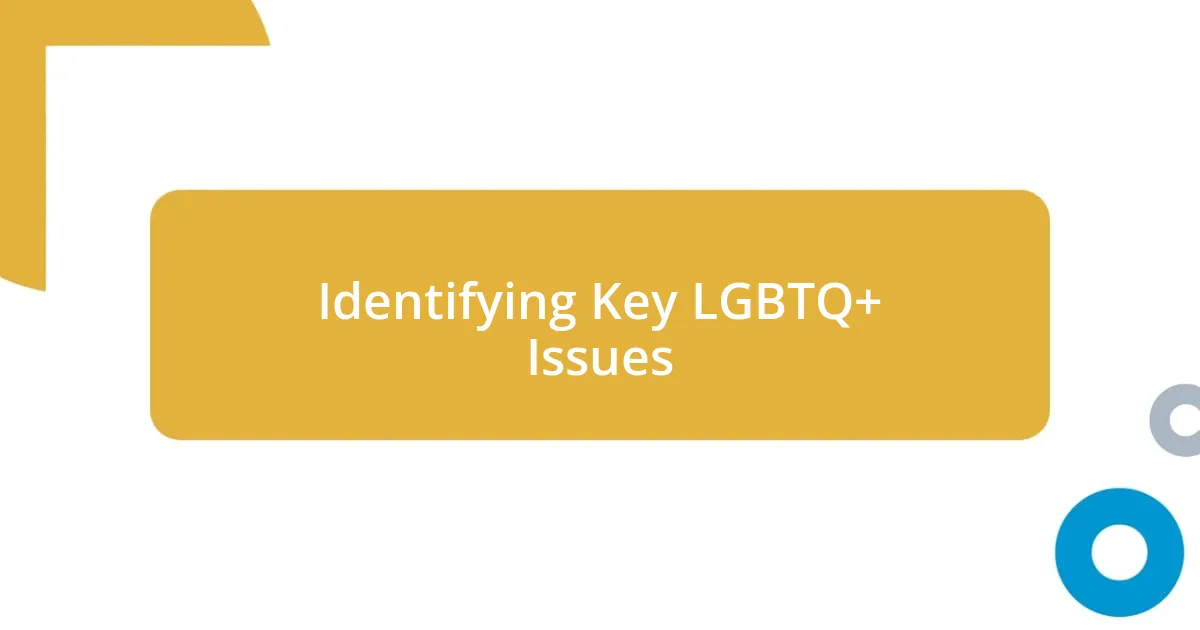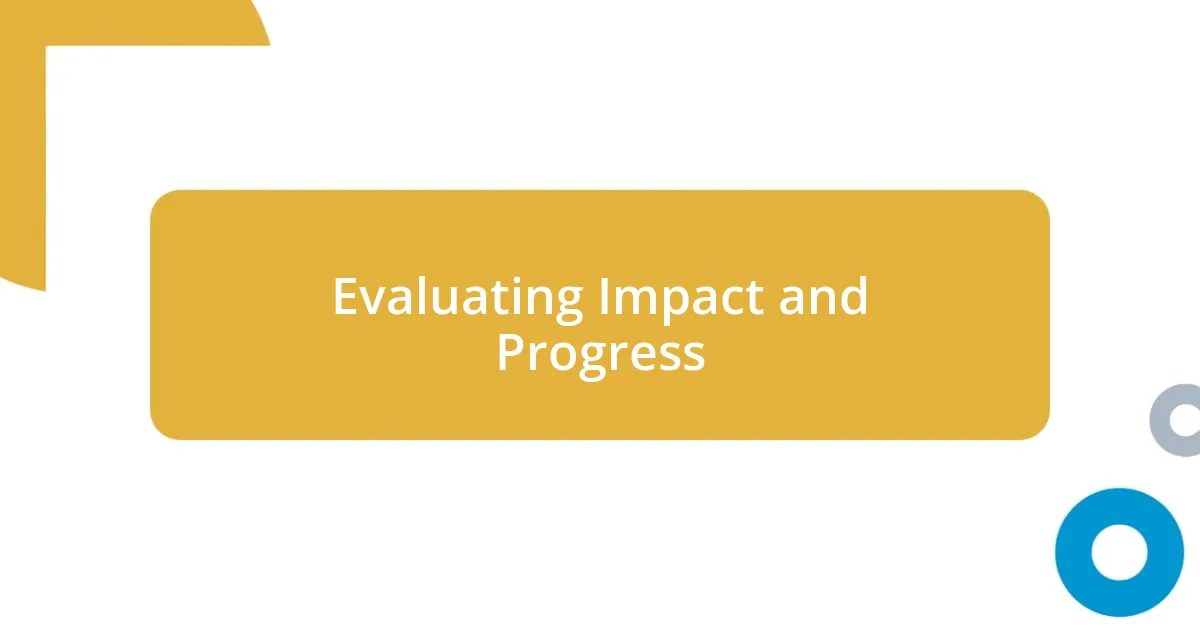Key takeaways:
- Understanding LGBTQ+ terminology, including using correct pronouns, fosters empathy and respect for individual identities.
- Key issues facing the LGBTQ+ community include discrimination, lack of representation, and ongoing struggles for legal rights.
- Creating inclusive educational environments involves using inclusive language, implementing diverse curricula, and establishing support systems for LGBTQ+ students.
- Engaging in community involvement and utilizing resources like workshops and social media enhances awareness and fosters dialogue about LGBTQ+ issues.

Understanding LGBTQ+ Terminology
Understanding LGBTQ+ terminology can sometimes feel overwhelming, but it’s crucial for fostering respect and empathy. I remember the first time I encountered the term “non-binary.” At that moment, I was struck by the realization that gender isn’t a strict binary of male and female—it’s much more fluid and personal.
As I dove deeper, I found that language in the LGBTQ+ community evolves quickly. Terms like “genderqueer” or “pansexual” might seem foreign, yet they represent individuals’ attempts to articulate their identities and experiences. Have you ever been in a conversation where you felt lost because you didn’t understand a term? I have, and it made me realize how important it is to ask questions and engage in open dialogues to promote understanding.
Another aspect I’ve learned is the importance of using correct pronouns. This simple act can significantly impact someone’s sense of belonging. It reminds me of a conversation I had with a close friend who identifies as transgender; they shared how being called by their correct pronouns made them feel seen and respected. This emotional connection underscores the power of understanding and using LGBTQ+ terminology appropriately.

Identifying Key LGBTQ+ Issues
Identifying key LGBTQ+ issues requires a keen awareness of the diverse challenges faced by this community. From discrimination in the workplace to access to healthcare, the struggles are both systemic and deeply personal. I recall a friend of mine who faced barriers when seeking mental health support due to their sexual orientation. It was heartbreaking to see how fear of stigma impacted their well-being.
In addition to discrimination, there’s the pressing concern of representation in media and politics. When I watch a film or read a book featuring LGBTQ+ characters, I often feel a sense of validation and connection. Unfortunately, many stories still overlook marginalized voices within our community, such as transgender individuals and people of color. The lack of representation affects not only those individuals but also society’s understanding of diverse experiences.
Lastly, the issue of legal rights, such as marriage equality and adoption, remains pivotal. I vividly remember the euphoria during the Supreme Court’s ruling on same-sex marriage; it was a moment where love and acceptance overcame fear and prejudice. Yet, we cannot ignore that in many parts of the world, LGBTQ+ individuals still fight for basic rights and justice. This discrepancy highlights the ongoing battle for equality that continues today.
| Issue | Description |
|---|---|
| Discrimination | Systemic barriers affecting LGBTQ+ individuals in various contexts, including employment and healthcare. |
| Representation | Lack of diverse and authentic portrayals of LGBTQ+ lives in media and politics. |
| Legal Rights | Ongoing struggles for rights such as marriage equality and adoption across different regions. |

Creating Inclusive Education Environments
Creating inclusive education environments requires intentional effort and genuine understanding. I recall a time when I volunteered as a mentor in a local school. One particular student, who identified as genderfluid, faced bullying and isolation from peers. It was a wake-up call for me—recognizing how much impact a supportive environment can have on someone’s well-being. By collaborating with educators to establish guidelines that embrace diversity, we made a noticeable difference. This taught me that fostering inclusion is not just about awareness; it’s about creating spaces where all students feel valued.
To effectively create these inclusive environments, it’s essential to incorporate key strategies:
- Use inclusive language: Encouraging educators and students to use terms and pronouns that respect individual identities can help minimize misconceptions and promote respect.
- Implement diverse curricula: Introducing literature, history, and lessons that reflect LGBTQ+ experiences enriches students’ understanding and promotes empathy.
- Offer training workshops: Regular training for staff on LGBTQ+ issues is crucial. When educators are well-informed, it creates a ripple effect throughout the entire school community.
- Establish support systems: Setting up safe spaces and support groups for LGBTQ+ students can significantly enhance their sense of belonging and community within the school.
- Engage parents and guardians: Educating families about LGBTQ+ issues fosters a wider community of support, ensuring inclusivity extends beyond school walls.
These steps can lead to a profound sense of acceptance and safety, allowing every student to thrive in their educational journey.

Methods for Effective Communication
When it comes to effective communication on LGBTQ+ issues, listening is paramount. I remember a discussion I had with a colleague who was curious about transgender identities. Instead of just throwing facts at them, I invited them to share their thoughts and questions first. This approach not only made them feel valued but also created a relaxed atmosphere for open conversation. Have you ever experienced a moment where genuine curiosity leads to deeper understanding? I find that’s often where meaningful dialogue begins.
Another powerful method is storytelling. By sharing personal experiences, I create a connection that statistics alone can’t. For instance, discussing a friend’s journey of self-acceptance illuminated the emotional struggles tied to societal expectations. People respond to stories because they resonate on a human level. When I reflect on these narratives, I see how they amplify empathy and break down the barriers of misunderstanding. Aren’t we all moved by stories that touch our hearts?
Using visuals and interactive tools is also incredibly effective in conveying complex topics. During a workshop I facilitated, we incorporated videos and infographics that illustrated the spectrum of gender identities. The change in engagement was noticeable; suddenly, participants were not just passive listeners but became active participants. Isn’t it fascinating how visuals can spark curiosity and motivate deeper exploration? Effective communication is about making content digestible and relatable, fostering a safe space where all voices are heard and valued.

Utilizing Resources and Tools
Utilizing resources and tools is essential in educating others about LGBTQ+ issues. One of the best resources I’ve found is online platforms dedicated to LGBTQ+ education. I often share articles and videos from credible organizations with friends or colleagues seeking to understand more. I still remember the first time I introduced a coworker to a documentary about the Stonewall riots. Their eyes lit up as they connected historical struggles with present-day advocacy. Have you ever experienced that spark of understanding in someone when they realize the broader context of a discussion? It’s these moments that fuel my passion for sharing knowledge.
Another effective tool is social media, which I’ve discovered can create powerful networks of support. I joined several groups focused on LGBTQ+ rights, and the discussions are often enlightening. Just last week, a member shared a personal story about coming out to their family, which spurred an engaging conversation that helped countless individuals feel less alone in their experiences. I learned so much from their journey, and it highlighted the importance of community in education. Isn’t it incredible how a simple post can resonate so deeply and encourage collective growth?
I’ve also found workshops and webinars to be invaluable for expanding my understanding and fostering dialogue. While attending a training session on intersectionality within the LGBTQ+ community, I was moved by the diverse perspectives shared by attendees. Each person’s unique experience illuminated aspects I hadn’t considered before. Engaging with others who are passionate about the same cause can not only deepen knowledge but also strengthen a sense of solidarity. Have you ever left a workshop feeling empowered to make a change? I certainly have, and those feelings push me to continue spreading awareness and understanding.

Engaging in Community Involvement
Engaging in community involvement is an essential way to educate ourselves and others about LGBTQ+ issues. Volunteering at local LGBTQ+ centers has opened my eyes to countless stories that often go unheard. For example, during a pride event, I met a young trans person who shared their journey of resilience and courage in the face of adversity. Their narrative wasn’t just about their identity; it was a powerful reminder of the importance of community support. Have you ever felt the weight of someone’s experience reshape your understanding? Connecting with individuals actively involved in their own journeys is incredibly enlightening.
Participating in community discussions has also been a transformative experience for me. I recall attending a panel where activists spoke about the intersection of race and LGBTQ+ rights. The passion and urgency in their voices encouraged me to reflect on my privilege and the ways I can contribute to the dialogue. It’s incredible how these conversations can shift perceptions and motivate action. Don’t you think that understanding the nuances of our shared experiences is crucial for building a more inclusive society?
Moreover, organizing and attending workshops fosters collaboration within the community. I once helped coordinate a workshop that focused on mental health for LGBTQ+ youth, and seeing those young attendees connect and share their stories was profound. The room was filled with vulnerability and strength, emphasizing how essential it is to provide safe spaces for open dialogue. Engaging with individuals willing to share their struggles and triumphs can create a ripple effect of understanding. Isn’t it inspiring to think how our collective experiences can lead to growth and healing for everyone involved?

Evaluating Impact and Progress
Evaluating the impact of my efforts is key to understanding how effectively I’ve educated others on LGBTQ+ issues. Each time I engage in a discussion, I look for feedback—often, the most enlightening moments come from unexpected questions. I remember a conversation with a friend who asked how to address LGBTQ+ topics with their kids. That sparked a revealing dialogue about their experiences and misconceptions, and it made me realize just how vital it is to listen and adapt my approach based on the audience’s needs.
Tracking progress also involves reflecting on the changes in attitudes around me. I recently attended a family gathering where discussions about gender identity flowed freely, something I would have never imagined a couple of years ago. Seeing relatives openly share their thoughts showed me that my efforts—small as they may seem—are making a difference. Have you ever witnessed a conversation evolve into something more supportive and inclusive? Those moments remind me that change isn’t always loud; sometimes, it’s quiet but profound.
Additionally, I often think about the ripple effects of my educational efforts. After presenting at a local school, I was approached by a teacher who wanted to implement more inclusive practices in her classroom. The realization that my words could inspire action not just in individuals, but in institutions, filled me with hope. Isn’t it powerful to consider that each conversation could potentially influence dozens more? That’s the kind of progress that fuels my commitment to continue advocating for LGBTQ+ understanding and acceptance.














